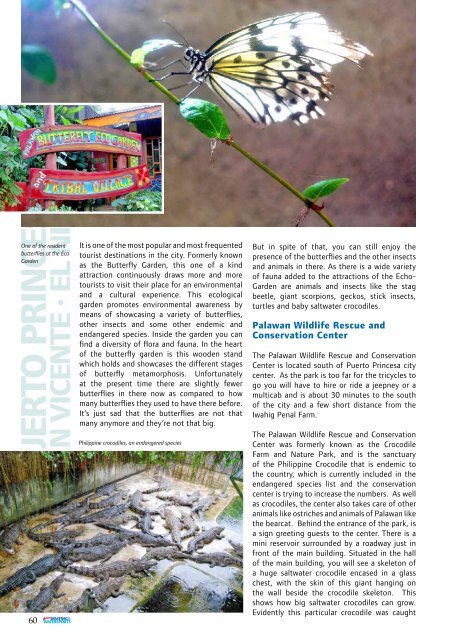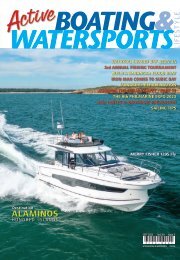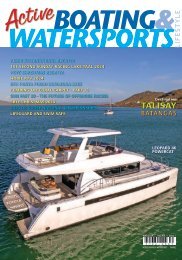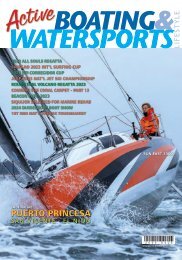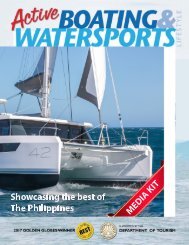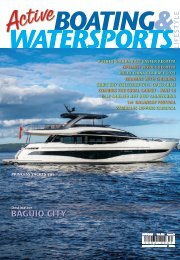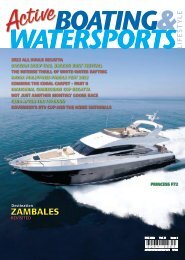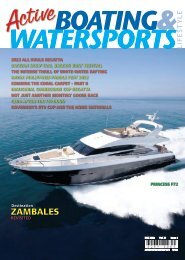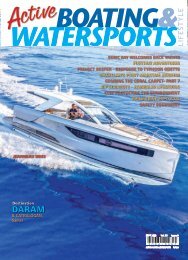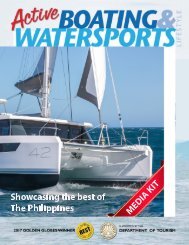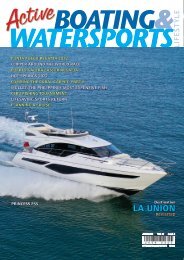ABW Sept 2017
Create successful ePaper yourself
Turn your PDF publications into a flip-book with our unique Google optimized e-Paper software.
PUERTO PRINCESA<br />
60<br />
SAN VICENTE . EL NIDO<br />
One of the resident<br />
butterflies at the Eco<br />
Garden<br />
It is one of the most popular and most frequented<br />
tourist destinations in the city. Formerly known<br />
as the Butterfly Garden, this one of a kind<br />
attraction continuously draws more and more<br />
tourists to visit their place for an environmental<br />
and a cultural experience. This ecological<br />
garden promotes environmental awareness by<br />
means of showcasing a variety of butterflies,<br />
other insects and some other endemic and<br />
endangered species. Inside the garden you can<br />
find a diversity of flora and fauna. In the heart<br />
of the butterfly garden is this wooden stand<br />
which holds and showcases the different stages<br />
of butterfly metamorphosis. Unfortunately<br />
at the present time there are slightly fewer<br />
butterflies in there now as compared to how<br />
many butterflies they used to have there before.<br />
It’s just sad that the butterflies are not that<br />
many anymore and they’re not that big.<br />
Philippine crocodiles, an endangered species<br />
But in spite of that, you can still enjoy the<br />
presence of the butterflies and the other insects<br />
and animals in there. As there is a wide variety<br />
of fauna added to the attractions of the Echo-<br />
Garden are animals and insects like the stag<br />
beetle, giant scorpions, geckos, stick insects,<br />
turtles and baby saltwater crocodiles.<br />
Palawan Wildlife Rescue and<br />
Conservation Center<br />
The Palawan Wildlife Rescue and Conservation<br />
Center is located south of Puerto Princesa city<br />
center. As the park is too far for the tricycles to<br />
go you will have to hire or ride a jeepney or a<br />
multicab and is about 30 minutes to the south<br />
of the city and a few short distance from the<br />
Iwahig Penal Farm.<br />
The Palawan Wildlife Rescue and Conservation<br />
Center was formerly known as the Crocodile<br />
Farm and Nature Park, and is the sanctuary<br />
of the Philippine Crocodile that is endemic to<br />
the country, which is currently included in the<br />
endangered species list and the conservation<br />
center is trying to increase the numbers. As well<br />
as crocodiles, the center also takes care of other<br />
animals like ostriches and animals of Palawan like<br />
the bearcat. Behind the entrance of the park, is<br />
a sign greeting guests to the center. There is a<br />
mini reservoir surrounded by a roadway just in<br />
front of the main building. Situated in the hall<br />
of the main building, you will see a skeleton of<br />
a huge saltwater crocodile encased in a glass<br />
chest, with the skin of this giant hanging on<br />
the wall beside the crocodile skeleton. This<br />
shows how big saltwater crocodiles can grow.<br />
Evidently this particular crocodile was caught<br />
somewhere on the island and was killed after it<br />
devoured a child.<br />
Displayed near the crocodile casing is the<br />
skeleton of a sperm whale, the skeleton was<br />
retrieved from a dead whale found on the shores<br />
of Puerto Princesa. There is also a small museum<br />
about crocodiles and other fossils.<br />
Just a few meters from the main hall, is the<br />
Hatchling House. Here, crocodiles are cared for<br />
by the conservation center and are segregated<br />
into different levels of maturity from egg to a<br />
Evidently this particular<br />
crocodile was caught<br />
somewhere on the island<br />
and was killed after it<br />
devoured a child.<br />
few months old. The hatchling house has a main<br />
passage in the middle where visitors are allowed<br />
to walk through and see the basins on each side<br />
of the path that contain up to 15 to 20 crocodile<br />
hatchlings. Further into the building, you will<br />
see the older crocodile hatchlings. There is a<br />
sign warning on guests to not extend any body<br />
part into the basins as the baby crocs snap and<br />
sometimes leap from the basin.<br />
Outside near the hatchlings is a concrete<br />
enclosure for the more mature crocodiles. There<br />
is a metal path over the top of the enclosures<br />
where visitors may walk across the top to<br />
the other end. The enclosure is divided into<br />
sections where some contain the huge saltwater<br />
crocodiles. Then, there are two larger sections<br />
that contain dozens of smaller adult crocodiles.<br />
After the crocodile enclosures, visitors are also<br />
able to view other animals that the center have<br />
rescued and taking care of. There are also<br />
ostriches, Philippine cockatoos and bearcats<br />
housed at the center. Visitors to the center also<br />
have an opportunity to have pictures taken with<br />
the crocodiles of the center. For a small fee and<br />
the assistance of center staff you may take hold<br />
of a baby crocodile and have your picture taken.<br />
Ugong Rock<br />
Taking its name from the reverbariting echoing<br />
sounds of the rocks and stalactites that is<br />
produced when tapping the rocks is located in<br />
the northern part of Puerto Princesa. Ugong<br />
Kayak Racing in<br />
Palompon<br />
Skin and bones of<br />
a huge crocodile on<br />
display at the Center<br />
61


